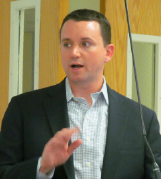The East Williston Board of Education’s financial advisory committee recommended the creation of a capital project reserve fund and an increase in the 2013-14 budget to $625,000 to address the district’s infrastructure needs in a budget workshop presentation last Wednesday night.
“We’re going to recommend that the capital reserve line item be set at $625,000,” said Steve Leccese, a member of the seven-member advisory committee.
The board had tentatively set a capital maintenance line in the 2013-14 budget at $225,000.
Leccese said as the district has been forced to pay increasing pension and health benefit costs, “we’ve underfunded capital projects in the budget process.”
“We already know we’ve underfunded that capital repair line,” said board President Mark Kamberg.
Kamberg said the financial committee has told the board the 2013-14 budget line for capital maintenance line should be set at a minimum of $400,000. He said the district maintains a capital repair reserve of $400,000 for repairs required beyond normal maintenance work.
Leccese said the committee foresees a need for as much as $10 million to fund capital projects to maintain district school buildings over the next five years. He said the committee favors creating a capital reserve fund as a “savings plan” for the district, beginning with the establishment of a $3 million five-year fund that could be fueled with state aid, the district’s annual overages and by seeking competitive grants.
The East Williston district currently has a surplus of $785,000 in its budget, according to Jacqueline Fitzgerald, district assistant superintendent for business. Leccese said the financial advisory committee recommends the board put the surplus funds in the capital reserve fund it wants the school district to establish.
To establish a capital project reserve fund, the board would need the approval of school district residents in the upcoming May school board election. Kamberg said he thinks the board will put the issue on the ballot.
Board Vice President Robert Fallorino said the board currently maintained an unappropriated reserve fund to defray the cost of the double-digit percentage increases in employee pension and health-care costs over the past several years.
Leccese said the district Financial Advisory Committee thinks the board should take a comprehensive look at all district reserve funds.
Leccese said the percentage increase in the 2013-14 budget, currently projected at a 3.15 percent year-to-year increase to $54,38 million, would approximately double if the district maintained all programs and personnel.
“Absent any cuts, the budget would grow 7 percent this year,” he said.
The board cut more than $2 million from what would have been a $56.41 million budget with a 7 percent year-to-year increase. The cuts, including the elimination of eight full-time employment positions, were needed to comply with the state-mandated tax cap. As it heard the financial committee’s presentation on Wednesday night, the board planned to finalize next year’s school budget at its Monday night meeting. But the meeting was postponed a week.
Leccese said the committee projects the need for an additional $2 million in cuts in the 2014-15 school district budget.
He said the committee projects the district’s cost per student will increase from its current level of $30,371 to $31,732 next year.
The district’s budget costs are composed of 77 percent in employee wages in benefits and the committee expects the double-digit percentage increase in benefit costs to continue over the next several years, he said. He said average employee compensation had risen by 50 percent over the past decade with 45 percent of that comprising benefits costs which have been “accelerating” over the past several years. He said teacher retirement increases will be 45 times higher in next year’s budget than they are at current levels.
“This is not sustainable,” Leccese said. “The cost to providing this to our employee base had gone up dramatically.”
He noted employees contributions for benefits had been increased over the past two contracts negotiated to levels of 10 percent to 20 percent. He said the recommends setting a 30 percent target in future negotiations for employee contributions to health benefits.
“We need to keep slowing the rate of growth,” he said.
Leccese also endorsed the idea of long-term financial planning for the district and said the Financial Advisory Committee has created a multi-year forecast model as a budget planning tool.



